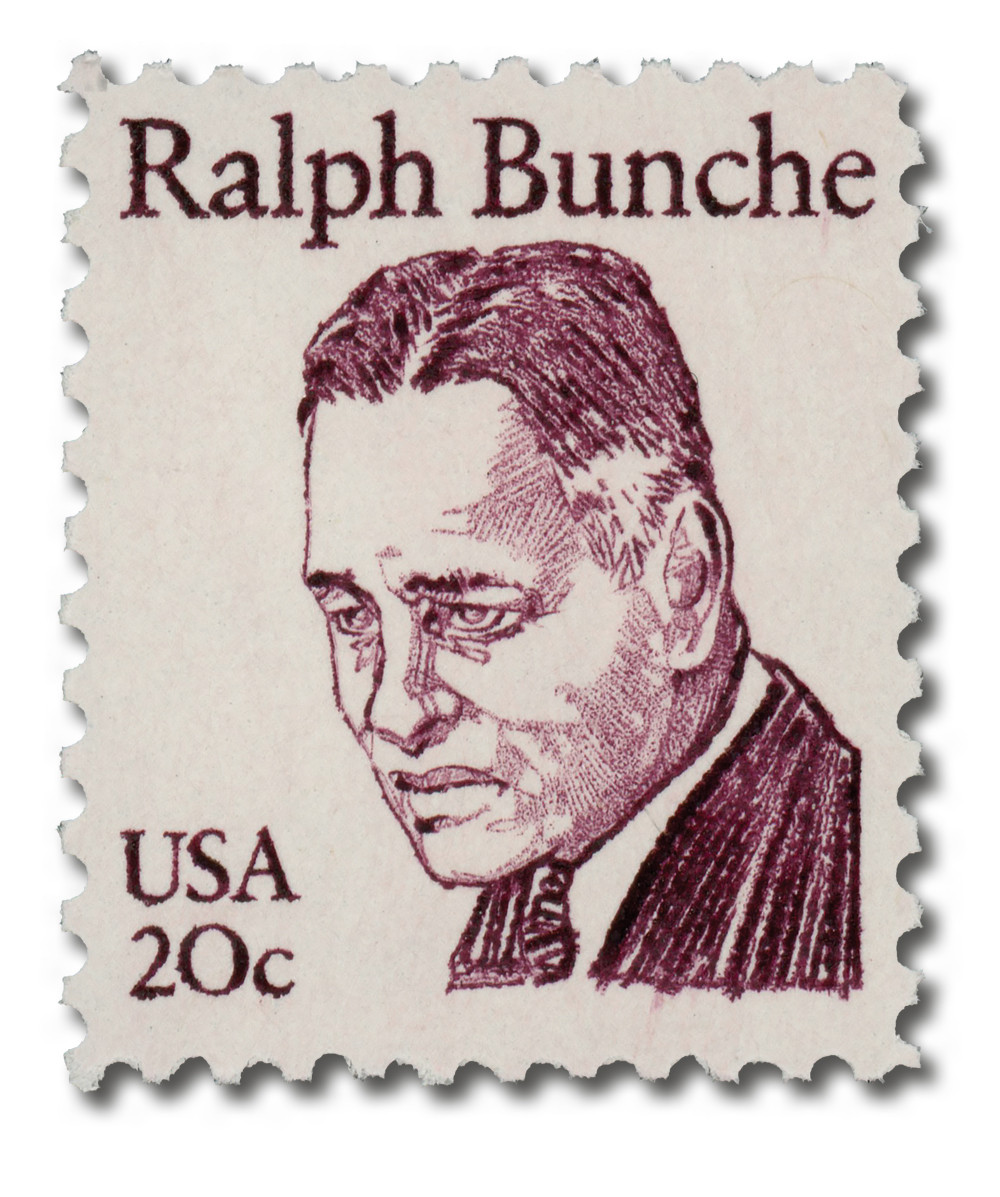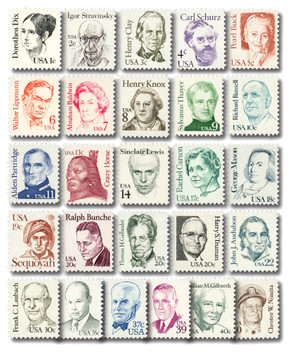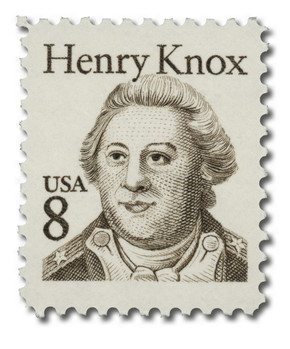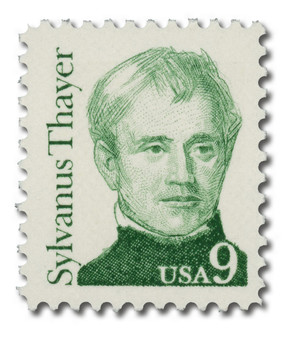
U.S. #1860
1982 20¢ Ralph Bunche
Great Americans
- 5th stamp in the Great Americans Series
- Issued at the United Nations in NY, where Bunch served as under-secretary from 1955 to 1971
- Issued just one month after he was eligible to be honored on a stamp under the 20-year rule
Stamp Category: Definitive
Series: Great Americans
Value: 20¢; first-class rate
First Day of Issue: January 12, 1982
First Day City: New York, New York
Printed by: Bureau of Engraving & Printing
Printing Method: Engraved
Format: Panes of 100
Perforations: 11 x 10.5
Color: Claret
Why the stamp was issued: To meet the first-class rate. This was the first of four 20¢ stamps in the Great Americans Series.
About the stamp design: Jim Sharpe create the portrait on this stamp.
First Day City: The First Day ceremony for this stamp was held at the United Nations General Assembly Building in New York City, New York.
About the Great Americans Series: The Great Americans Series was created to replace the Americana Series. The new series would be characterized by a standard definitive size, simple design, and monochromatic colors.
This simple design included a portrait, “USA,” the denomination, the person’s name, and in some cases, their occupation or reason for recognition. The first stamp in the new series was issued on December 27, 1980. It honored Sequoyah and fulfilled the new international postcard rate that would go into effect in January 1981.
The Great Americans Series would honor a wider range of people than the previous Prominent Americans and Liberty Series. While those series mainly honored presidents and politicians, the Great Americans Series featured people from many fields and ethnicities. They were individuals who were leaders in education, the military, literature, the arts, and human and civil rights. Plus, while the previous series only honored a few women, the Great Americans featured 15 women. This was also the first definitive series to honor Native Americans, with five stamps.
The Bureau of Engraving and Printing (BEP) produced most of the stamps, but private firms printed some. Several stamps saw multiple printings. The result was many different varieties, with tagging being the key to understanding them. Though there were also differences in perforations, gum, paper, and ink color.
The final stamp in the series was issued on July 17, 1999, honoring Justin S. Morrill. Spanning 20 years, the Great Americans was the longest-running US definitive series. It was also the largest series of face-different stamps, with a total of 63.
Click here for all the individual stamps and click here for the complete series.
History the stamp represents: Ralph Johnson Bunche was born on August 7, 1904, in Detroit, Michigan.
In his youth, Bunche and his family moved around a bit, spending time in Toledo, Ohio; Albuquerque, New Mexico; and Los Angeles, California. He was a bright student, a member of the debate team, and the valedictorian of his high school class.
Bunche attended the University of California, Los Angeles, where he again graduated as valedictorian. From there, he went on to Harvard and earned his doctorate in political science. Bunche was the first African American to earn a PhD in political science at an American college. While he was still earning his doctorate, Bunche began teaching political science at Howard University. He then published his first book, World View of Race, in 1936.
During World War II, Bunche worked for the Office of Strategic Services, which later became the CIA. He worked as a senior social analyst for Colonial Affairs. Then in 1943, he was moved to the State Department, where he worked as associate chief of the Division of Dependent Area Affairs. In that role, he was a leader of the Institute of Pacific Relations.
While serving in the Department of State, Bunche was a delegate or advisor to nine international conferences in just four years. In 1944, he joined the early planning for the United Nations Conference on International Organization in San Francisco. During the same conference, Bunche was an adviser to the US delegation. Bunche, along with Eleanor Roosevelt, is considered a major force in the adoption of the Universal Declaration of Human Rights. In 1946, he became director of the UN Department of Trusteeship. From 1955 to 1971, Bunche served as under-secretary of the UN.
In 1947, Bunche joined in the negotiations to end the Arab-Israeli conflict in Palestine. He was part of the UN Special Committee on Palestine and traveled to the Middle East to mediate the discussions. When the chief mediator was assassinated, Bunche replaced him and helped negotiate an armistice, reportedly over playing pool with the Israeli representative. For his service, Bunche was awarded the Nobel Peace Prize in 1950, making him the first African American ever to receive this illustrious award.
Bunche worked actively, as an American citizen and as UN under-secretary-general, for improved race relations, human rights, decolonization, and international peacekeeping. His work contributed to the decolonization of several nations and advanced human rights around the world. Bunche’s influence can still be seen in the UN’s peacekeeping strategies and conflict resolutions today.
Bunche was also an active supporter of the civil rights movement. He wrote articles, delivered speeches in support, and attended the March on Washington and the Selma March.
Bunche was made under-secretary-general of the UN in 1968. However, his health began to decline and he resigned within a few years. Bunche died on December 9, 1971. In addition to his Nobel Peace Prize, Bunche received the NAACP’s Spingarn Medal and the Boy Scouts’ Silver Buffalo Award. Several buildings, parks, schools, and other locations have been named in his honor.
U.S. #1860
1982 20¢ Ralph Bunche
Great Americans
- 5th stamp in the Great Americans Series
- Issued at the United Nations in NY, where Bunch served as under-secretary from 1955 to 1971
- Issued just one month after he was eligible to be honored on a stamp under the 20-year rule
Stamp Category: Definitive
Series: Great Americans
Value: 20¢; first-class rate
First Day of Issue: January 12, 1982
First Day City: New York, New York
Printed by: Bureau of Engraving & Printing
Printing Method: Engraved
Format: Panes of 100
Perforations: 11 x 10.5
Color: Claret
Why the stamp was issued: To meet the first-class rate. This was the first of four 20¢ stamps in the Great Americans Series.
About the stamp design: Jim Sharpe create the portrait on this stamp.
First Day City: The First Day ceremony for this stamp was held at the United Nations General Assembly Building in New York City, New York.
About the Great Americans Series: The Great Americans Series was created to replace the Americana Series. The new series would be characterized by a standard definitive size, simple design, and monochromatic colors.
This simple design included a portrait, “USA,” the denomination, the person’s name, and in some cases, their occupation or reason for recognition. The first stamp in the new series was issued on December 27, 1980. It honored Sequoyah and fulfilled the new international postcard rate that would go into effect in January 1981.
The Great Americans Series would honor a wider range of people than the previous Prominent Americans and Liberty Series. While those series mainly honored presidents and politicians, the Great Americans Series featured people from many fields and ethnicities. They were individuals who were leaders in education, the military, literature, the arts, and human and civil rights. Plus, while the previous series only honored a few women, the Great Americans featured 15 women. This was also the first definitive series to honor Native Americans, with five stamps.
The Bureau of Engraving and Printing (BEP) produced most of the stamps, but private firms printed some. Several stamps saw multiple printings. The result was many different varieties, with tagging being the key to understanding them. Though there were also differences in perforations, gum, paper, and ink color.
The final stamp in the series was issued on July 17, 1999, honoring Justin S. Morrill. Spanning 20 years, the Great Americans was the longest-running US definitive series. It was also the largest series of face-different stamps, with a total of 63.
Click here for all the individual stamps and click here for the complete series.
History the stamp represents: Ralph Johnson Bunche was born on August 7, 1904, in Detroit, Michigan.
In his youth, Bunche and his family moved around a bit, spending time in Toledo, Ohio; Albuquerque, New Mexico; and Los Angeles, California. He was a bright student, a member of the debate team, and the valedictorian of his high school class.
Bunche attended the University of California, Los Angeles, where he again graduated as valedictorian. From there, he went on to Harvard and earned his doctorate in political science. Bunche was the first African American to earn a PhD in political science at an American college. While he was still earning his doctorate, Bunche began teaching political science at Howard University. He then published his first book, World View of Race, in 1936.
During World War II, Bunche worked for the Office of Strategic Services, which later became the CIA. He worked as a senior social analyst for Colonial Affairs. Then in 1943, he was moved to the State Department, where he worked as associate chief of the Division of Dependent Area Affairs. In that role, he was a leader of the Institute of Pacific Relations.
While serving in the Department of State, Bunche was a delegate or advisor to nine international conferences in just four years. In 1944, he joined the early planning for the United Nations Conference on International Organization in San Francisco. During the same conference, Bunche was an adviser to the US delegation. Bunche, along with Eleanor Roosevelt, is considered a major force in the adoption of the Universal Declaration of Human Rights. In 1946, he became director of the UN Department of Trusteeship. From 1955 to 1971, Bunche served as under-secretary of the UN.
In 1947, Bunche joined in the negotiations to end the Arab-Israeli conflict in Palestine. He was part of the UN Special Committee on Palestine and traveled to the Middle East to mediate the discussions. When the chief mediator was assassinated, Bunche replaced him and helped negotiate an armistice, reportedly over playing pool with the Israeli representative. For his service, Bunche was awarded the Nobel Peace Prize in 1950, making him the first African American ever to receive this illustrious award.
Bunche worked actively, as an American citizen and as UN under-secretary-general, for improved race relations, human rights, decolonization, and international peacekeeping. His work contributed to the decolonization of several nations and advanced human rights around the world. Bunche’s influence can still be seen in the UN’s peacekeeping strategies and conflict resolutions today.
Bunche was also an active supporter of the civil rights movement. He wrote articles, delivered speeches in support, and attended the March on Washington and the Selma March.
Bunche was made under-secretary-general of the UN in 1968. However, his health began to decline and he resigned within a few years. Bunche died on December 9, 1971. In addition to his Nobel Peace Prize, Bunche received the NAACP’s Spingarn Medal and the Boy Scouts’ Silver Buffalo Award. Several buildings, parks, schools, and other locations have been named in his honor.















